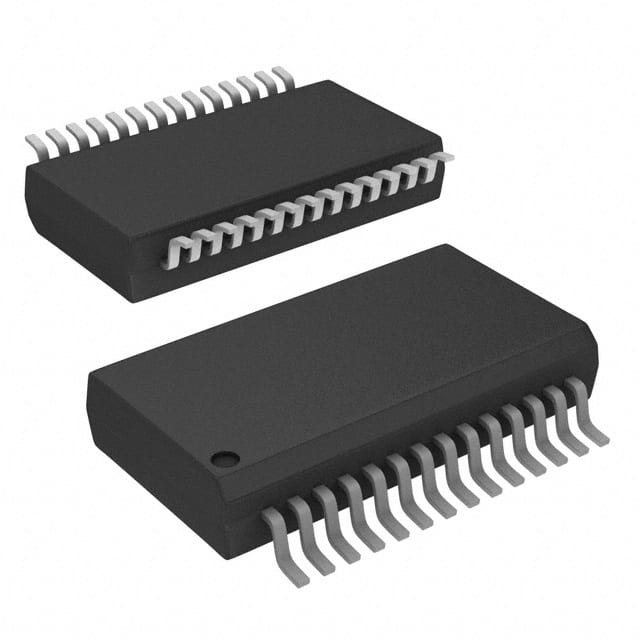Viz Specifikace pro podrobnosti o produktu.

PIC16C57CT-40/SS
Product Overview
Category
The PIC16C57CT-40/SS belongs to the category of microcontrollers.
Use
This microcontroller is commonly used in various electronic devices and embedded systems for controlling and processing data.
Characteristics
- High-performance 8-bit RISC architecture
- Low power consumption
- Wide operating voltage range
- Integrated flash memory for program storage
- Multiple I/O ports for versatile connectivity
- On-chip timers and counters for precise timing operations
Package
The PIC16C57CT-40/SS is available in a SSOP (Shrink Small Outline Package) package.
Essence
The essence of this microcontroller lies in its ability to provide efficient and reliable control and processing capabilities in a compact form factor.
Packaging/Quantity
The PIC16C57CT-40/SS is typically packaged in reels, with each reel containing a specified quantity of microcontrollers.
Specifications
- Architecture: 8-bit RISC
- Program Memory Size: 2KB
- RAM Size: 72 bytes
- Operating Voltage Range: 2.5V to 5.5V
- Maximum CPU Speed: 40 MHz
- Number of I/O Pins: 20
- Timers/Counters: 3
- ADC Channels: 5
- Communication Interfaces: SPI, USART, MSSP
Detailed Pin Configuration
The PIC16C57CT-40/SS has a total of 20 pins, each serving a specific purpose. The pin configuration is as follows:
- VDD - Power supply voltage
- RA0 - General-purpose I/O pin
- RA1 - General-purpose I/O pin
- RA2 - General-purpose I/O pin
- RA3 - General-purpose I/O pin
- RA4 - General-purpose I/O pin
- RA5/AN4 - General-purpose I/O pin / Analog input channel 4
- VSS - Ground
- OSC1/CLKIN - Oscillator input / External clock input
- OSC2/CLKOUT - Oscillator output / Clock output
- RC0 - General-purpose I/O pin
- RC1 - General-purpose I/O pin
- RC2 - General-purpose I/O pin
- RC3 - General-purpose I/O pin
- RC4 - General-purpose I/O pin
- RC5 - General-purpose I/O pin
- MCLR/VPP - Master Clear input / Programming voltage supply
- RB0/INT - General-purpose I/O pin / External interrupt input
- RB1 - General-purpose I/O pin
- RB2 - General-purpose I/O pin
Functional Features
The PIC16C57CT-40/SS microcontroller offers several functional features that enhance its performance and versatility:
- Flash Memory: The integrated flash memory allows for easy reprogramming of the microcontroller, enabling flexibility in application development.
- Timers and Counters: The on-chip timers and counters facilitate precise timing operations, making it suitable for time-critical applications.
- Communication Interfaces: The SPI, USART, and MSSP interfaces enable seamless communication with other devices, expanding connectivity options.
- Analog-to-Digital Converter (ADC): The built-in ADC channels allow for analog signal conversion, enabling measurement and control of analog inputs.
Advantages and Disadvantages
Advantages
- High-performance RISC architecture ensures efficient processing capabilities.
- Low power consumption extends battery life in portable applications.
- Wide operating voltage range provides compatibility with various power sources.
- Integrated flash memory simplifies program storage and updates.
- Multiple I/O ports offer flexibility in connecting external devices.
Disadvantages
- Limited program memory size may restrict the complexity of applications.
- Limited RAM size may impose constraints on data storage and manipulation.
- Lack of advanced peripherals compared to more modern microcontrollers.
Working Principles
The PIC16C57CT-40/SS operates based on an 8-bit RISC architecture. It executes instructions stored in its flash memory, utilizing various on-chip resources such as timers, counters, and I/O ports. The microcontroller interacts with external devices through its communication interfaces and processes data according to the programmed instructions. It continuously performs these operations to control and monitor the connected system.
Detailed Application Field Plans
The PIC16C57CT-40/SS finds applications in a wide range of fields, including but not limited to:
- Industrial Automation: Controlling and monitoring industrial machinery and processes.
- Consumer Electronics: Power management, user interface control, and device connectivity in electronic appliances.
- Automotive Systems: Engine control units, dashboard displays, and sensor interfacing.
- Medical Devices: Patient monitoring systems, medical equipment control, and data acquisition.
Seznam 10 běžných otázek a odpovědí souvisejících s aplikací PIC16C57CT-40/SS v technických řešeních
What is the operating voltage range of PIC16C57CT-40/SS?
- The operating voltage range of PIC16C57CT-40/SS is 2.0V to 6.0V.What is the maximum frequency of the oscillator in PIC16C57CT-40/SS?
- The maximum frequency of the oscillator in PIC16C57CT-40/SS is 20 MHz.Can PIC16C57CT-40/SS be used in battery-powered applications?
- Yes, PIC16C57CT-40/SS can be used in battery-powered applications due to its low power consumption.What are the communication interfaces supported by PIC16C57CT-40/SS?
- PIC16C57CT-40/SS supports USART and SPI communication interfaces.Is PIC16C57CT-40/SS suitable for temperature-sensitive environments?
- Yes, PIC16C57CT-40/SS has a wide operating temperature range of -40°C to 125°C, making it suitable for temperature-sensitive environments.Can PIC16C57CT-40/SS be programmed using a high-level language like C?
- Yes, PIC16C57CT-40/SS can be programmed using high-level languages like C using appropriate compilers.What are the available memory options in PIC16C57CT-40/SS?
- PIC16C57CT-40/SS has 2K x 14 words of Flash program memory and 72 bytes of data memory.Does PIC16C57CT-40/SS have built-in analog-to-digital conversion capabilities?
- No, PIC16C57CT-40/SS does not have built-in analog-to-digital conversion capabilities.Can PIC16C57CT-40/SS be used in automotive applications?
- Yes, PIC16C57CT-40/SS is suitable for automotive applications due to its robust design and wide operating temperature range.What development tools are available for programming and debugging PIC16C57CT-40/SS?
- Development tools such as MPLAB X IDE and PICkit programmers/debuggers can be used for programming and debugging PIC16C57CT-40/SS.

